Circular Economy in Kuala Lumpur: Progress, Barriers, and Opportunities
VerifiedAdded on 2022/12/22
|14
|4108
|1
AI Summary
This document discusses the concept of circular economy and its adoption in Kuala Lumpur, Malaysia. It explores the progress, barriers, and opportunities for the development of circular economy in the city. The document also proposes actions that local and international companies, as well as the local government, can take to support the growth of circular economy.
Contribute Materials
Your contribution can guide someone’s learning journey. Share your
documents today.
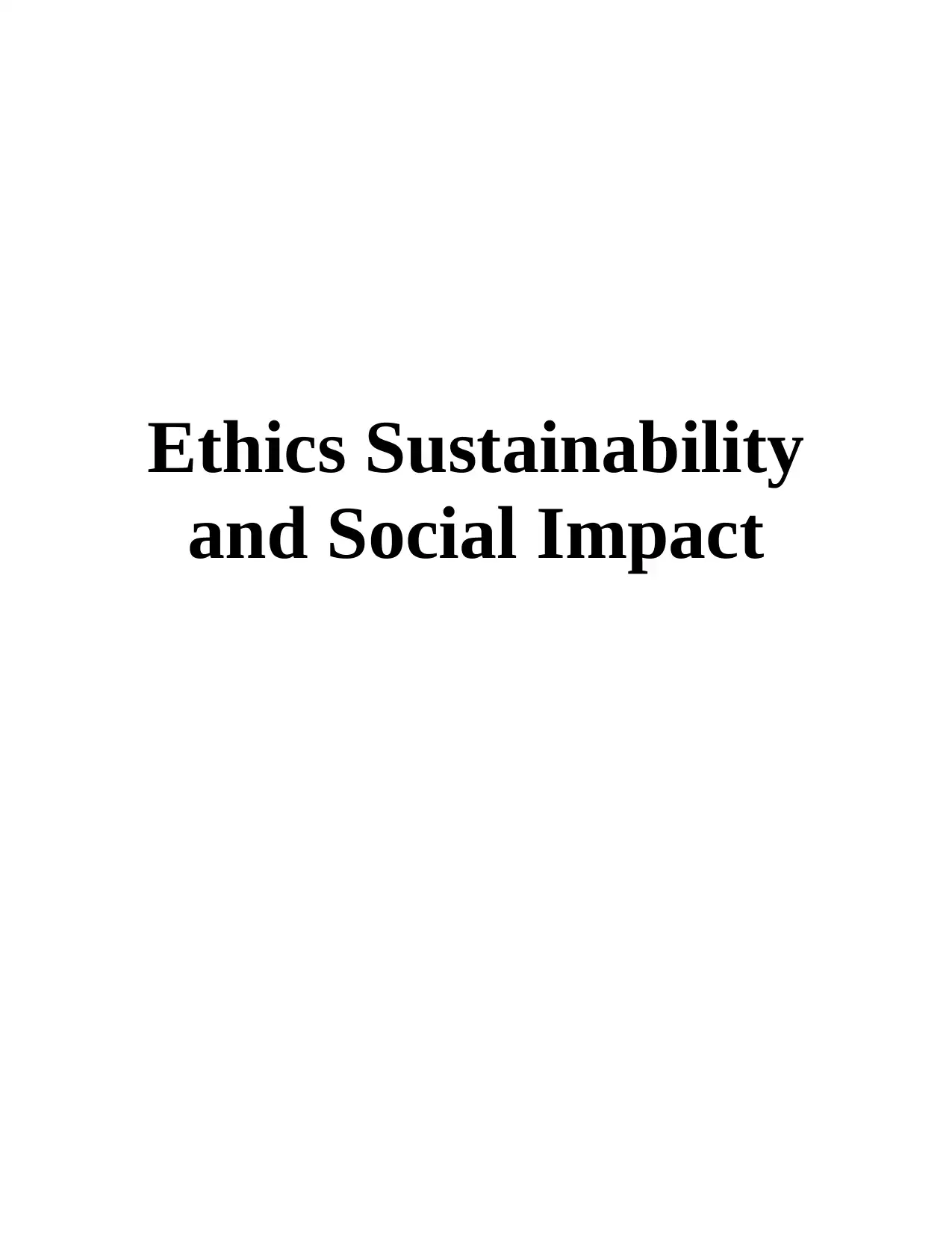
Ethics Sustainability
and Social Impact
and Social Impact
Secure Best Marks with AI Grader
Need help grading? Try our AI Grader for instant feedback on your assignments.
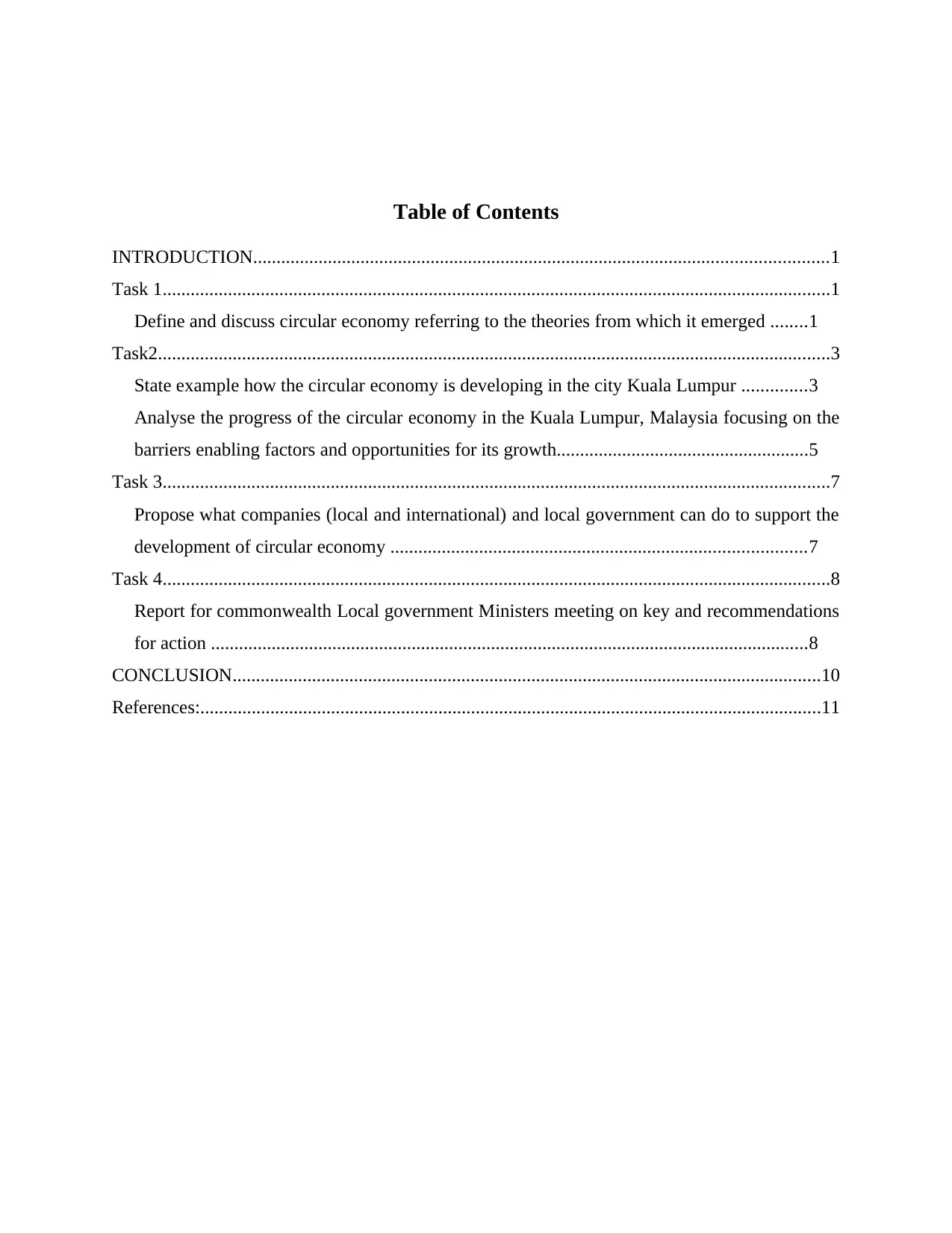
Table of Contents
INTRODUCTION...........................................................................................................................1
Task 1...............................................................................................................................................1
Define and discuss circular economy referring to the theories from which it emerged ........1
Task2................................................................................................................................................3
State example how the circular economy is developing in the city Kuala Lumpur ..............3
Analyse the progress of the circular economy in the Kuala Lumpur, Malaysia focusing on the
barriers enabling factors and opportunities for its growth......................................................5
Task 3...............................................................................................................................................7
Propose what companies (local and international) and local government can do to support the
development of circular economy .........................................................................................7
Task 4...............................................................................................................................................8
Report for commonwealth Local government Ministers meeting on key and recommendations
for action ................................................................................................................................8
CONCLUSION..............................................................................................................................10
References:.....................................................................................................................................11
INTRODUCTION...........................................................................................................................1
Task 1...............................................................................................................................................1
Define and discuss circular economy referring to the theories from which it emerged ........1
Task2................................................................................................................................................3
State example how the circular economy is developing in the city Kuala Lumpur ..............3
Analyse the progress of the circular economy in the Kuala Lumpur, Malaysia focusing on the
barriers enabling factors and opportunities for its growth......................................................5
Task 3...............................................................................................................................................7
Propose what companies (local and international) and local government can do to support the
development of circular economy .........................................................................................7
Task 4...............................................................................................................................................8
Report for commonwealth Local government Ministers meeting on key and recommendations
for action ................................................................................................................................8
CONCLUSION..............................................................................................................................10
References:.....................................................................................................................................11
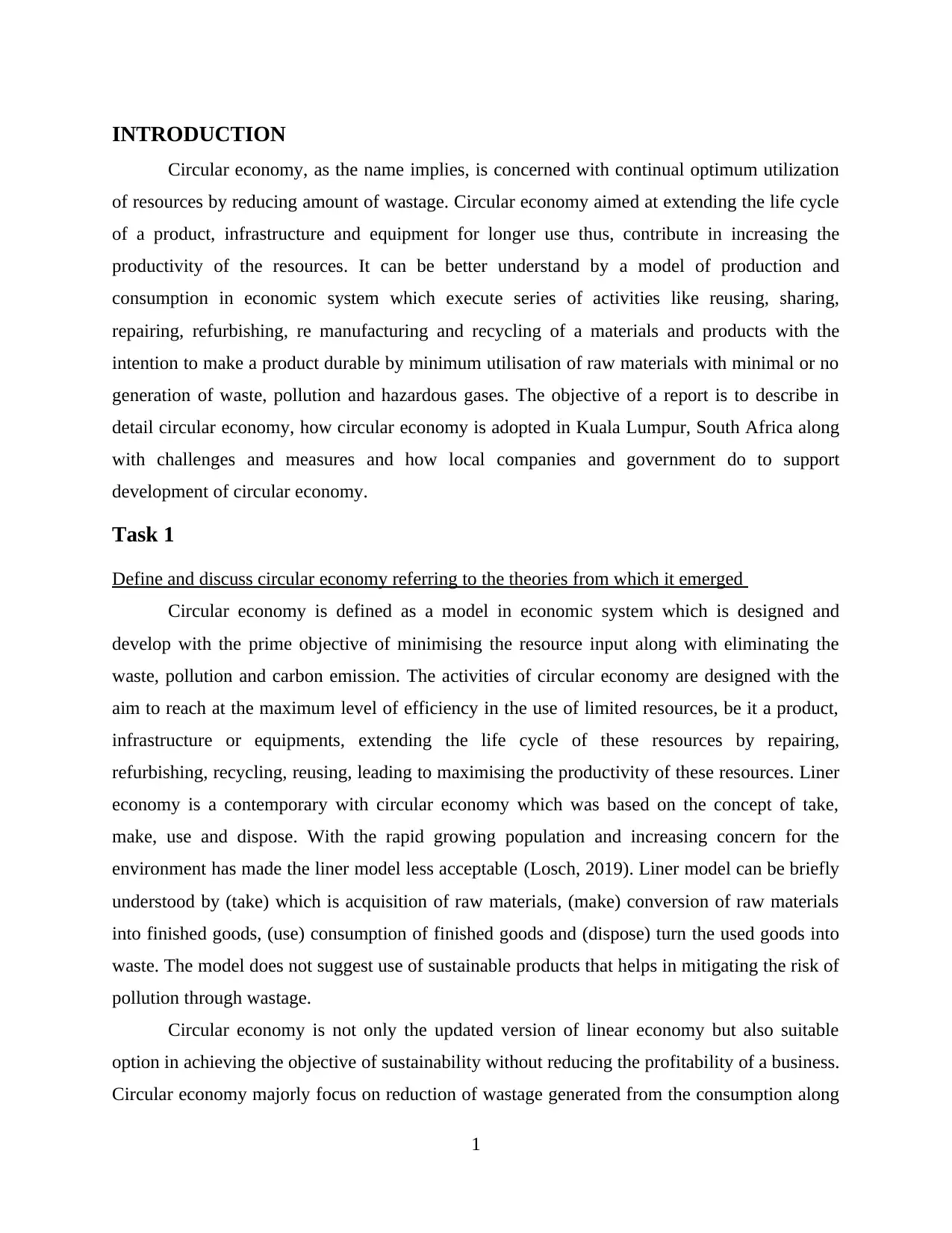
INTRODUCTION
Circular economy, as the name implies, is concerned with continual optimum utilization
of resources by reducing amount of wastage. Circular economy aimed at extending the life cycle
of a product, infrastructure and equipment for longer use thus, contribute in increasing the
productivity of the resources. It can be better understand by a model of production and
consumption in economic system which execute series of activities like reusing, sharing,
repairing, refurbishing, re manufacturing and recycling of a materials and products with the
intention to make a product durable by minimum utilisation of raw materials with minimal or no
generation of waste, pollution and hazardous gases. The objective of a report is to describe in
detail circular economy, how circular economy is adopted in Kuala Lumpur, South Africa along
with challenges and measures and how local companies and government do to support
development of circular economy.
Task 1
Define and discuss circular economy referring to the theories from which it emerged
Circular economy is defined as a model in economic system which is designed and
develop with the prime objective of minimising the resource input along with eliminating the
waste, pollution and carbon emission. The activities of circular economy are designed with the
aim to reach at the maximum level of efficiency in the use of limited resources, be it a product,
infrastructure or equipments, extending the life cycle of these resources by repairing,
refurbishing, recycling, reusing, leading to maximising the productivity of these resources. Liner
economy is a contemporary with circular economy which was based on the concept of take,
make, use and dispose. With the rapid growing population and increasing concern for the
environment has made the liner model less acceptable (Losch, 2019). Liner model can be briefly
understood by (take) which is acquisition of raw materials, (make) conversion of raw materials
into finished goods, (use) consumption of finished goods and (dispose) turn the used goods into
waste. The model does not suggest use of sustainable products that helps in mitigating the risk of
pollution through wastage.
Circular economy is not only the updated version of linear economy but also suitable
option in achieving the objective of sustainability without reducing the profitability of a business.
Circular economy majorly focus on reduction of wastage generated from the consumption along
1
Circular economy, as the name implies, is concerned with continual optimum utilization
of resources by reducing amount of wastage. Circular economy aimed at extending the life cycle
of a product, infrastructure and equipment for longer use thus, contribute in increasing the
productivity of the resources. It can be better understand by a model of production and
consumption in economic system which execute series of activities like reusing, sharing,
repairing, refurbishing, re manufacturing and recycling of a materials and products with the
intention to make a product durable by minimum utilisation of raw materials with minimal or no
generation of waste, pollution and hazardous gases. The objective of a report is to describe in
detail circular economy, how circular economy is adopted in Kuala Lumpur, South Africa along
with challenges and measures and how local companies and government do to support
development of circular economy.
Task 1
Define and discuss circular economy referring to the theories from which it emerged
Circular economy is defined as a model in economic system which is designed and
develop with the prime objective of minimising the resource input along with eliminating the
waste, pollution and carbon emission. The activities of circular economy are designed with the
aim to reach at the maximum level of efficiency in the use of limited resources, be it a product,
infrastructure or equipments, extending the life cycle of these resources by repairing,
refurbishing, recycling, reusing, leading to maximising the productivity of these resources. Liner
economy is a contemporary with circular economy which was based on the concept of take,
make, use and dispose. With the rapid growing population and increasing concern for the
environment has made the liner model less acceptable (Losch, 2019). Liner model can be briefly
understood by (take) which is acquisition of raw materials, (make) conversion of raw materials
into finished goods, (use) consumption of finished goods and (dispose) turn the used goods into
waste. The model does not suggest use of sustainable products that helps in mitigating the risk of
pollution through wastage.
Circular economy is not only the updated version of linear economy but also suitable
option in achieving the objective of sustainability without reducing the profitability of a business.
Circular economy majorly focus on reduction of wastage generated from the consumption along
1
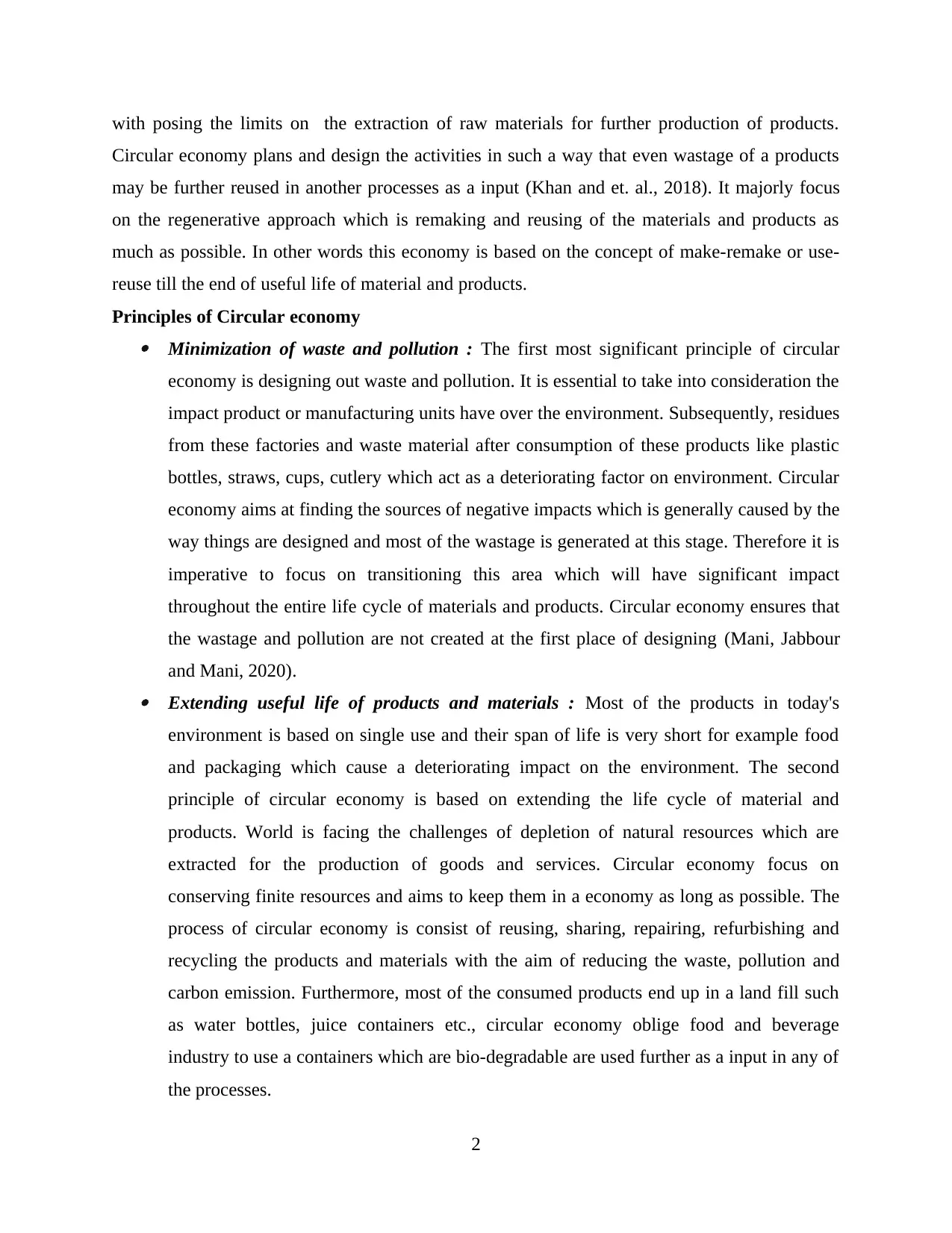
with posing the limits on the extraction of raw materials for further production of products.
Circular economy plans and design the activities in such a way that even wastage of a products
may be further reused in another processes as a input (Khan and et. al., 2018). It majorly focus
on the regenerative approach which is remaking and reusing of the materials and products as
much as possible. In other words this economy is based on the concept of make-remake or use-
reuse till the end of useful life of material and products.
Principles of Circular economy Minimization of waste and pollution : The first most significant principle of circular
economy is designing out waste and pollution. It is essential to take into consideration the
impact product or manufacturing units have over the environment. Subsequently, residues
from these factories and waste material after consumption of these products like plastic
bottles, straws, cups, cutlery which act as a deteriorating factor on environment. Circular
economy aims at finding the sources of negative impacts which is generally caused by the
way things are designed and most of the wastage is generated at this stage. Therefore it is
imperative to focus on transitioning this area which will have significant impact
throughout the entire life cycle of materials and products. Circular economy ensures that
the wastage and pollution are not created at the first place of designing (Mani, Jabbour
and Mani, 2020). Extending useful life of products and materials : Most of the products in today's
environment is based on single use and their span of life is very short for example food
and packaging which cause a deteriorating impact on the environment. The second
principle of circular economy is based on extending the life cycle of material and
products. World is facing the challenges of depletion of natural resources which are
extracted for the production of goods and services. Circular economy focus on
conserving finite resources and aims to keep them in a economy as long as possible. The
process of circular economy is consist of reusing, sharing, repairing, refurbishing and
recycling the products and materials with the aim of reducing the waste, pollution and
carbon emission. Furthermore, most of the consumed products end up in a land fill such
as water bottles, juice containers etc., circular economy oblige food and beverage
industry to use a containers which are bio-degradable are used further as a input in any of
the processes.
2
Circular economy plans and design the activities in such a way that even wastage of a products
may be further reused in another processes as a input (Khan and et. al., 2018). It majorly focus
on the regenerative approach which is remaking and reusing of the materials and products as
much as possible. In other words this economy is based on the concept of make-remake or use-
reuse till the end of useful life of material and products.
Principles of Circular economy Minimization of waste and pollution : The first most significant principle of circular
economy is designing out waste and pollution. It is essential to take into consideration the
impact product or manufacturing units have over the environment. Subsequently, residues
from these factories and waste material after consumption of these products like plastic
bottles, straws, cups, cutlery which act as a deteriorating factor on environment. Circular
economy aims at finding the sources of negative impacts which is generally caused by the
way things are designed and most of the wastage is generated at this stage. Therefore it is
imperative to focus on transitioning this area which will have significant impact
throughout the entire life cycle of materials and products. Circular economy ensures that
the wastage and pollution are not created at the first place of designing (Mani, Jabbour
and Mani, 2020). Extending useful life of products and materials : Most of the products in today's
environment is based on single use and their span of life is very short for example food
and packaging which cause a deteriorating impact on the environment. The second
principle of circular economy is based on extending the life cycle of material and
products. World is facing the challenges of depletion of natural resources which are
extracted for the production of goods and services. Circular economy focus on
conserving finite resources and aims to keep them in a economy as long as possible. The
process of circular economy is consist of reusing, sharing, repairing, refurbishing and
recycling the products and materials with the aim of reducing the waste, pollution and
carbon emission. Furthermore, most of the consumed products end up in a land fill such
as water bottles, juice containers etc., circular economy oblige food and beverage
industry to use a containers which are bio-degradable are used further as a input in any of
the processes.
2
Secure Best Marks with AI Grader
Need help grading? Try our AI Grader for instant feedback on your assignments.
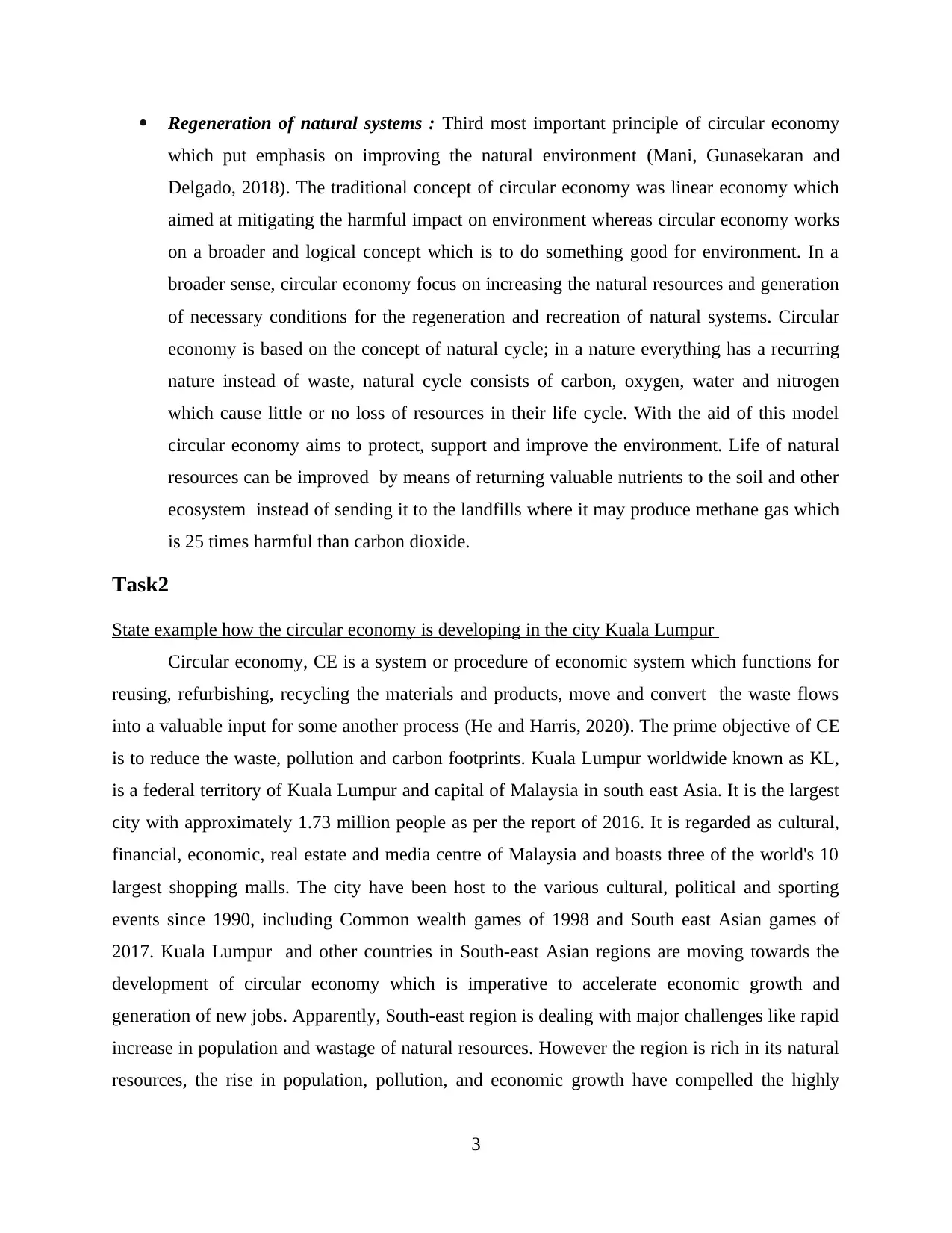
Regeneration of natural systems : Third most important principle of circular economy
which put emphasis on improving the natural environment (Mani, Gunasekaran and
Delgado, 2018). The traditional concept of circular economy was linear economy which
aimed at mitigating the harmful impact on environment whereas circular economy works
on a broader and logical concept which is to do something good for environment. In a
broader sense, circular economy focus on increasing the natural resources and generation
of necessary conditions for the regeneration and recreation of natural systems. Circular
economy is based on the concept of natural cycle; in a nature everything has a recurring
nature instead of waste, natural cycle consists of carbon, oxygen, water and nitrogen
which cause little or no loss of resources in their life cycle. With the aid of this model
circular economy aims to protect, support and improve the environment. Life of natural
resources can be improved by means of returning valuable nutrients to the soil and other
ecosystem instead of sending it to the landfills where it may produce methane gas which
is 25 times harmful than carbon dioxide.
Task2
State example how the circular economy is developing in the city Kuala Lumpur
Circular economy, CE is a system or procedure of economic system which functions for
reusing, refurbishing, recycling the materials and products, move and convert the waste flows
into a valuable input for some another process (He and Harris, 2020). The prime objective of CE
is to reduce the waste, pollution and carbon footprints. Kuala Lumpur worldwide known as KL,
is a federal territory of Kuala Lumpur and capital of Malaysia in south east Asia. It is the largest
city with approximately 1.73 million people as per the report of 2016. It is regarded as cultural,
financial, economic, real estate and media centre of Malaysia and boasts three of the world's 10
largest shopping malls. The city have been host to the various cultural, political and sporting
events since 1990, including Common wealth games of 1998 and South east Asian games of
2017. Kuala Lumpur and other countries in South-east Asian regions are moving towards the
development of circular economy which is imperative to accelerate economic growth and
generation of new jobs. Apparently, South-east region is dealing with major challenges like rapid
increase in population and wastage of natural resources. However the region is rich in its natural
resources, the rise in population, pollution, and economic growth have compelled the highly
3
which put emphasis on improving the natural environment (Mani, Gunasekaran and
Delgado, 2018). The traditional concept of circular economy was linear economy which
aimed at mitigating the harmful impact on environment whereas circular economy works
on a broader and logical concept which is to do something good for environment. In a
broader sense, circular economy focus on increasing the natural resources and generation
of necessary conditions for the regeneration and recreation of natural systems. Circular
economy is based on the concept of natural cycle; in a nature everything has a recurring
nature instead of waste, natural cycle consists of carbon, oxygen, water and nitrogen
which cause little or no loss of resources in their life cycle. With the aid of this model
circular economy aims to protect, support and improve the environment. Life of natural
resources can be improved by means of returning valuable nutrients to the soil and other
ecosystem instead of sending it to the landfills where it may produce methane gas which
is 25 times harmful than carbon dioxide.
Task2
State example how the circular economy is developing in the city Kuala Lumpur
Circular economy, CE is a system or procedure of economic system which functions for
reusing, refurbishing, recycling the materials and products, move and convert the waste flows
into a valuable input for some another process (He and Harris, 2020). The prime objective of CE
is to reduce the waste, pollution and carbon footprints. Kuala Lumpur worldwide known as KL,
is a federal territory of Kuala Lumpur and capital of Malaysia in south east Asia. It is the largest
city with approximately 1.73 million people as per the report of 2016. It is regarded as cultural,
financial, economic, real estate and media centre of Malaysia and boasts three of the world's 10
largest shopping malls. The city have been host to the various cultural, political and sporting
events since 1990, including Common wealth games of 1998 and South east Asian games of
2017. Kuala Lumpur and other countries in South-east Asian regions are moving towards the
development of circular economy which is imperative to accelerate economic growth and
generation of new jobs. Apparently, South-east region is dealing with major challenges like rapid
increase in population and wastage of natural resources. However the region is rich in its natural
resources, the rise in population, pollution, and economic growth have compelled the highly
3
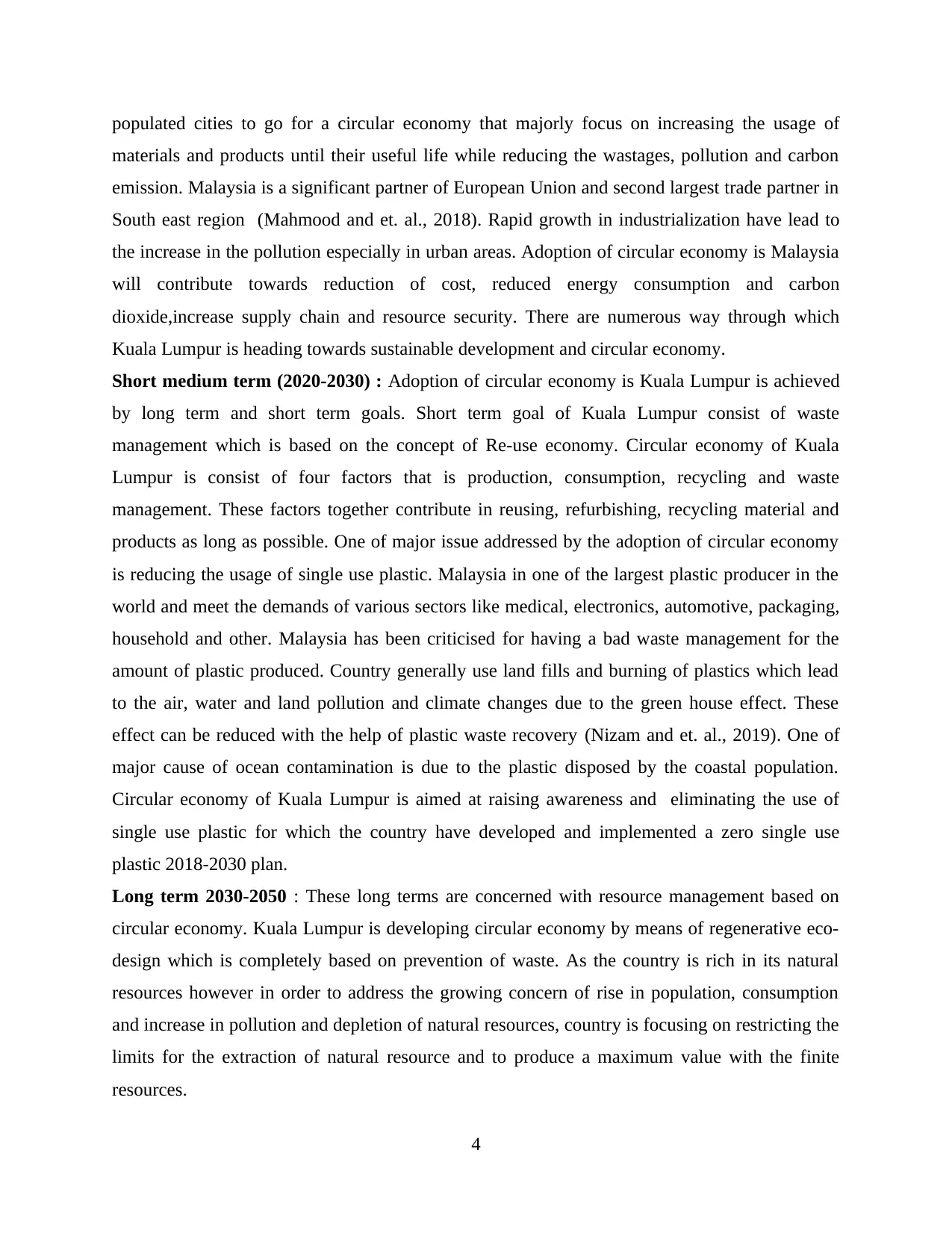
populated cities to go for a circular economy that majorly focus on increasing the usage of
materials and products until their useful life while reducing the wastages, pollution and carbon
emission. Malaysia is a significant partner of European Union and second largest trade partner in
South east region (Mahmood and et. al., 2018). Rapid growth in industrialization have lead to
the increase in the pollution especially in urban areas. Adoption of circular economy is Malaysia
will contribute towards reduction of cost, reduced energy consumption and carbon
dioxide,increase supply chain and resource security. There are numerous way through which
Kuala Lumpur is heading towards sustainable development and circular economy.
Short medium term (2020-2030) : Adoption of circular economy is Kuala Lumpur is achieved
by long term and short term goals. Short term goal of Kuala Lumpur consist of waste
management which is based on the concept of Re-use economy. Circular economy of Kuala
Lumpur is consist of four factors that is production, consumption, recycling and waste
management. These factors together contribute in reusing, refurbishing, recycling material and
products as long as possible. One of major issue addressed by the adoption of circular economy
is reducing the usage of single use plastic. Malaysia in one of the largest plastic producer in the
world and meet the demands of various sectors like medical, electronics, automotive, packaging,
household and other. Malaysia has been criticised for having a bad waste management for the
amount of plastic produced. Country generally use land fills and burning of plastics which lead
to the air, water and land pollution and climate changes due to the green house effect. These
effect can be reduced with the help of plastic waste recovery (Nizam and et. al., 2019). One of
major cause of ocean contamination is due to the plastic disposed by the coastal population.
Circular economy of Kuala Lumpur is aimed at raising awareness and eliminating the use of
single use plastic for which the country have developed and implemented a zero single use
plastic 2018-2030 plan.
Long term 2030-2050 : These long terms are concerned with resource management based on
circular economy. Kuala Lumpur is developing circular economy by means of regenerative eco-
design which is completely based on prevention of waste. As the country is rich in its natural
resources however in order to address the growing concern of rise in population, consumption
and increase in pollution and depletion of natural resources, country is focusing on restricting the
limits for the extraction of natural resource and to produce a maximum value with the finite
resources.
4
materials and products until their useful life while reducing the wastages, pollution and carbon
emission. Malaysia is a significant partner of European Union and second largest trade partner in
South east region (Mahmood and et. al., 2018). Rapid growth in industrialization have lead to
the increase in the pollution especially in urban areas. Adoption of circular economy is Malaysia
will contribute towards reduction of cost, reduced energy consumption and carbon
dioxide,increase supply chain and resource security. There are numerous way through which
Kuala Lumpur is heading towards sustainable development and circular economy.
Short medium term (2020-2030) : Adoption of circular economy is Kuala Lumpur is achieved
by long term and short term goals. Short term goal of Kuala Lumpur consist of waste
management which is based on the concept of Re-use economy. Circular economy of Kuala
Lumpur is consist of four factors that is production, consumption, recycling and waste
management. These factors together contribute in reusing, refurbishing, recycling material and
products as long as possible. One of major issue addressed by the adoption of circular economy
is reducing the usage of single use plastic. Malaysia in one of the largest plastic producer in the
world and meet the demands of various sectors like medical, electronics, automotive, packaging,
household and other. Malaysia has been criticised for having a bad waste management for the
amount of plastic produced. Country generally use land fills and burning of plastics which lead
to the air, water and land pollution and climate changes due to the green house effect. These
effect can be reduced with the help of plastic waste recovery (Nizam and et. al., 2019). One of
major cause of ocean contamination is due to the plastic disposed by the coastal population.
Circular economy of Kuala Lumpur is aimed at raising awareness and eliminating the use of
single use plastic for which the country have developed and implemented a zero single use
plastic 2018-2030 plan.
Long term 2030-2050 : These long terms are concerned with resource management based on
circular economy. Kuala Lumpur is developing circular economy by means of regenerative eco-
design which is completely based on prevention of waste. As the country is rich in its natural
resources however in order to address the growing concern of rise in population, consumption
and increase in pollution and depletion of natural resources, country is focusing on restricting the
limits for the extraction of natural resource and to produce a maximum value with the finite
resources.
4
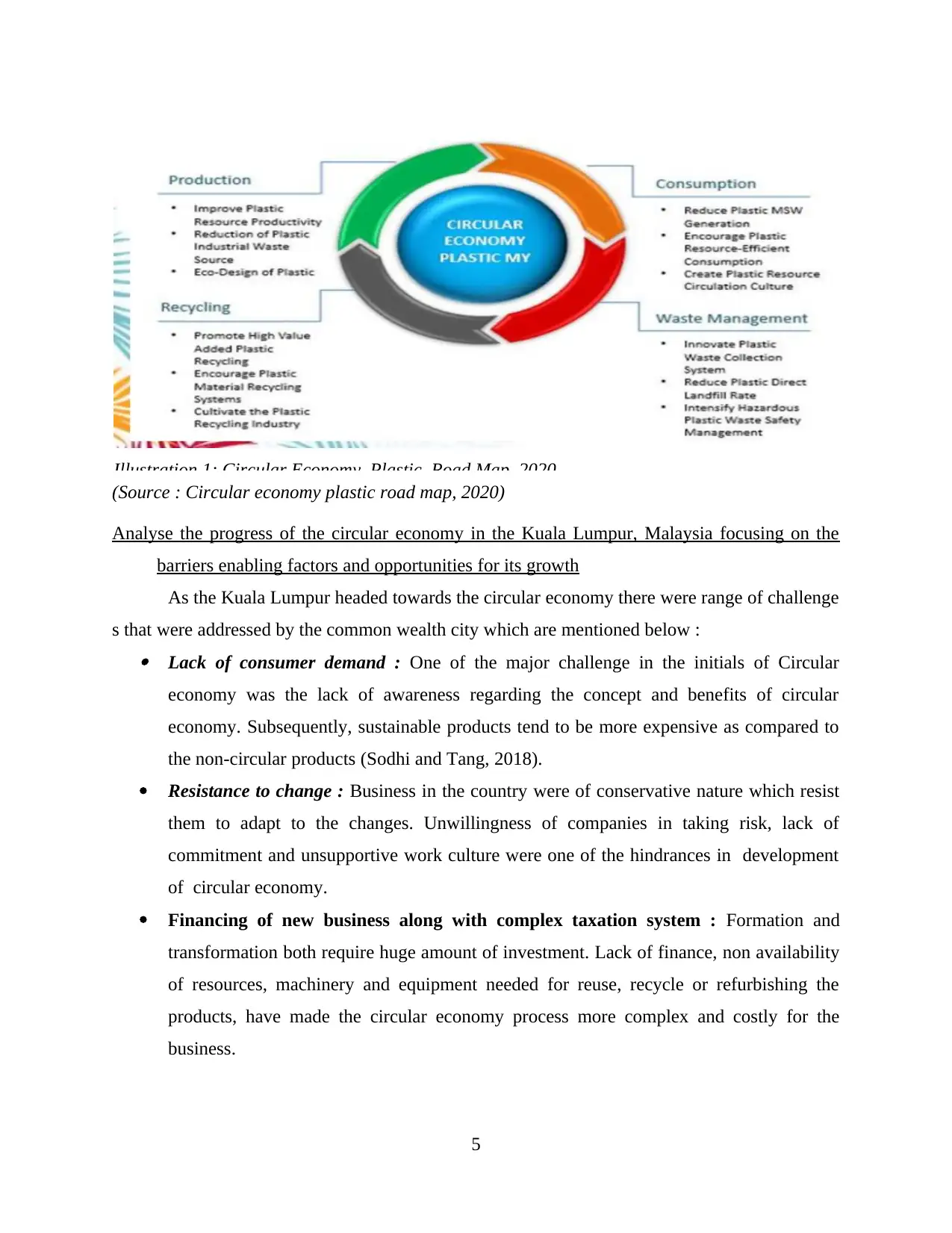
(Source : Circular economy plastic road map, 2020)
Analyse the progress of the circular economy in the Kuala Lumpur, Malaysia focusing on the
barriers enabling factors and opportunities for its growth
As the Kuala Lumpur headed towards the circular economy there were range of challenge
s that were addressed by the common wealth city which are mentioned below : Lack of consumer demand : One of the major challenge in the initials of Circular
economy was the lack of awareness regarding the concept and benefits of circular
economy. Subsequently, sustainable products tend to be more expensive as compared to
the non-circular products (Sodhi and Tang, 2018).
Resistance to change : Business in the country were of conservative nature which resist
them to adapt to the changes. Unwillingness of companies in taking risk, lack of
commitment and unsupportive work culture were one of the hindrances in development
of circular economy.
Financing of new business along with complex taxation system : Formation and
transformation both require huge amount of investment. Lack of finance, non availability
of resources, machinery and equipment needed for reuse, recycle or refurbishing the
products, have made the circular economy process more complex and costly for the
business.
5
Illustration 1: Circular Economy Plastic Road Map, 2020
Analyse the progress of the circular economy in the Kuala Lumpur, Malaysia focusing on the
barriers enabling factors and opportunities for its growth
As the Kuala Lumpur headed towards the circular economy there were range of challenge
s that were addressed by the common wealth city which are mentioned below : Lack of consumer demand : One of the major challenge in the initials of Circular
economy was the lack of awareness regarding the concept and benefits of circular
economy. Subsequently, sustainable products tend to be more expensive as compared to
the non-circular products (Sodhi and Tang, 2018).
Resistance to change : Business in the country were of conservative nature which resist
them to adapt to the changes. Unwillingness of companies in taking risk, lack of
commitment and unsupportive work culture were one of the hindrances in development
of circular economy.
Financing of new business along with complex taxation system : Formation and
transformation both require huge amount of investment. Lack of finance, non availability
of resources, machinery and equipment needed for reuse, recycle or refurbishing the
products, have made the circular economy process more complex and costly for the
business.
5
Illustration 1: Circular Economy Plastic Road Map, 2020
Paraphrase This Document
Need a fresh take? Get an instant paraphrase of this document with our AI Paraphraser
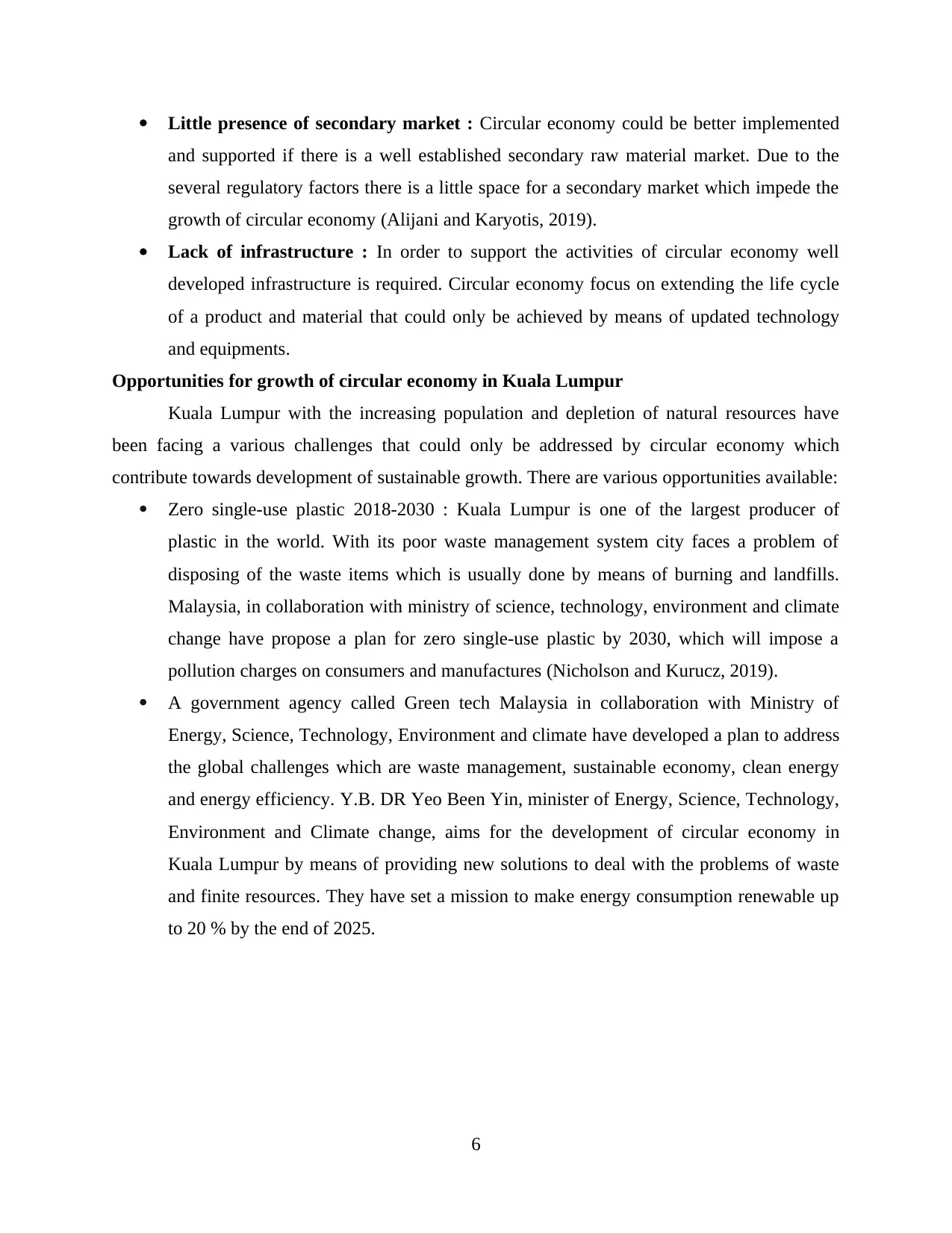
Little presence of secondary market : Circular economy could be better implemented
and supported if there is a well established secondary raw material market. Due to the
several regulatory factors there is a little space for a secondary market which impede the
growth of circular economy (Alijani and Karyotis, 2019).
Lack of infrastructure : In order to support the activities of circular economy well
developed infrastructure is required. Circular economy focus on extending the life cycle
of a product and material that could only be achieved by means of updated technology
and equipments.
Opportunities for growth of circular economy in Kuala Lumpur
Kuala Lumpur with the increasing population and depletion of natural resources have
been facing a various challenges that could only be addressed by circular economy which
contribute towards development of sustainable growth. There are various opportunities available:
Zero single-use plastic 2018-2030 : Kuala Lumpur is one of the largest producer of
plastic in the world. With its poor waste management system city faces a problem of
disposing of the waste items which is usually done by means of burning and landfills.
Malaysia, in collaboration with ministry of science, technology, environment and climate
change have propose a plan for zero single-use plastic by 2030, which will impose a
pollution charges on consumers and manufactures (Nicholson and Kurucz, 2019).
A government agency called Green tech Malaysia in collaboration with Ministry of
Energy, Science, Technology, Environment and climate have developed a plan to address
the global challenges which are waste management, sustainable economy, clean energy
and energy efficiency. Y.B. DR Yeo Been Yin, minister of Energy, Science, Technology,
Environment and Climate change, aims for the development of circular economy in
Kuala Lumpur by means of providing new solutions to deal with the problems of waste
and finite resources. They have set a mission to make energy consumption renewable up
to 20 % by the end of 2025.
6
and supported if there is a well established secondary raw material market. Due to the
several regulatory factors there is a little space for a secondary market which impede the
growth of circular economy (Alijani and Karyotis, 2019).
Lack of infrastructure : In order to support the activities of circular economy well
developed infrastructure is required. Circular economy focus on extending the life cycle
of a product and material that could only be achieved by means of updated technology
and equipments.
Opportunities for growth of circular economy in Kuala Lumpur
Kuala Lumpur with the increasing population and depletion of natural resources have
been facing a various challenges that could only be addressed by circular economy which
contribute towards development of sustainable growth. There are various opportunities available:
Zero single-use plastic 2018-2030 : Kuala Lumpur is one of the largest producer of
plastic in the world. With its poor waste management system city faces a problem of
disposing of the waste items which is usually done by means of burning and landfills.
Malaysia, in collaboration with ministry of science, technology, environment and climate
change have propose a plan for zero single-use plastic by 2030, which will impose a
pollution charges on consumers and manufactures (Nicholson and Kurucz, 2019).
A government agency called Green tech Malaysia in collaboration with Ministry of
Energy, Science, Technology, Environment and climate have developed a plan to address
the global challenges which are waste management, sustainable economy, clean energy
and energy efficiency. Y.B. DR Yeo Been Yin, minister of Energy, Science, Technology,
Environment and Climate change, aims for the development of circular economy in
Kuala Lumpur by means of providing new solutions to deal with the problems of waste
and finite resources. They have set a mission to make energy consumption renewable up
to 20 % by the end of 2025.
6
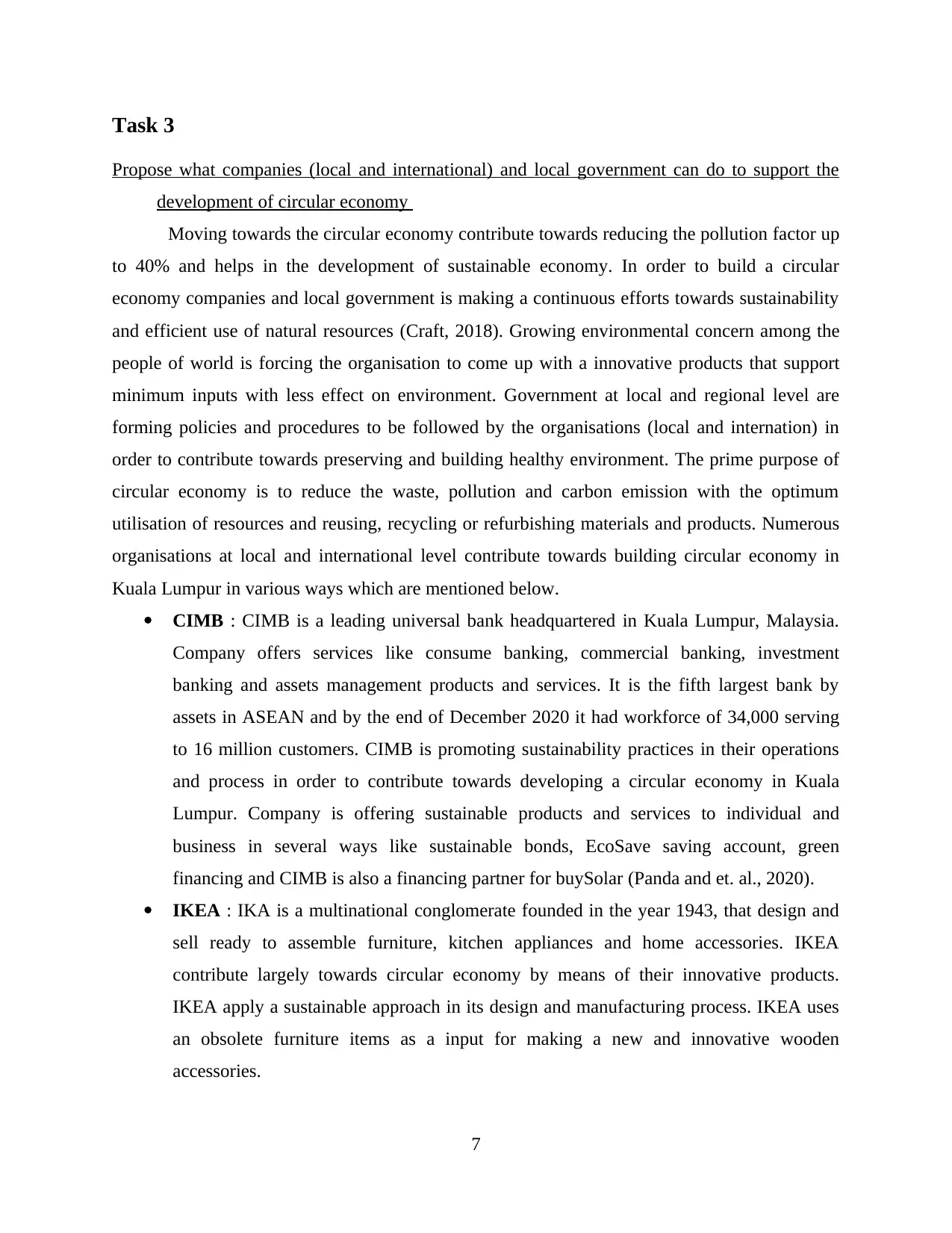
Task 3
Propose what companies (local and international) and local government can do to support the
development of circular economy
Moving towards the circular economy contribute towards reducing the pollution factor up
to 40% and helps in the development of sustainable economy. In order to build a circular
economy companies and local government is making a continuous efforts towards sustainability
and efficient use of natural resources (Craft, 2018). Growing environmental concern among the
people of world is forcing the organisation to come up with a innovative products that support
minimum inputs with less effect on environment. Government at local and regional level are
forming policies and procedures to be followed by the organisations (local and internation) in
order to contribute towards preserving and building healthy environment. The prime purpose of
circular economy is to reduce the waste, pollution and carbon emission with the optimum
utilisation of resources and reusing, recycling or refurbishing materials and products. Numerous
organisations at local and international level contribute towards building circular economy in
Kuala Lumpur in various ways which are mentioned below.
CIMB : CIMB is a leading universal bank headquartered in Kuala Lumpur, Malaysia.
Company offers services like consume banking, commercial banking, investment
banking and assets management products and services. It is the fifth largest bank by
assets in ASEAN and by the end of December 2020 it had workforce of 34,000 serving
to 16 million customers. CIMB is promoting sustainability practices in their operations
and process in order to contribute towards developing a circular economy in Kuala
Lumpur. Company is offering sustainable products and services to individual and
business in several ways like sustainable bonds, EcoSave saving account, green
financing and CIMB is also a financing partner for buySolar (Panda and et. al., 2020).
IKEA : IKA is a multinational conglomerate founded in the year 1943, that design and
sell ready to assemble furniture, kitchen appliances and home accessories. IKEA
contribute largely towards circular economy by means of their innovative products.
IKEA apply a sustainable approach in its design and manufacturing process. IKEA uses
an obsolete furniture items as a input for making a new and innovative wooden
accessories.
7
Propose what companies (local and international) and local government can do to support the
development of circular economy
Moving towards the circular economy contribute towards reducing the pollution factor up
to 40% and helps in the development of sustainable economy. In order to build a circular
economy companies and local government is making a continuous efforts towards sustainability
and efficient use of natural resources (Craft, 2018). Growing environmental concern among the
people of world is forcing the organisation to come up with a innovative products that support
minimum inputs with less effect on environment. Government at local and regional level are
forming policies and procedures to be followed by the organisations (local and internation) in
order to contribute towards preserving and building healthy environment. The prime purpose of
circular economy is to reduce the waste, pollution and carbon emission with the optimum
utilisation of resources and reusing, recycling or refurbishing materials and products. Numerous
organisations at local and international level contribute towards building circular economy in
Kuala Lumpur in various ways which are mentioned below.
CIMB : CIMB is a leading universal bank headquartered in Kuala Lumpur, Malaysia.
Company offers services like consume banking, commercial banking, investment
banking and assets management products and services. It is the fifth largest bank by
assets in ASEAN and by the end of December 2020 it had workforce of 34,000 serving
to 16 million customers. CIMB is promoting sustainability practices in their operations
and process in order to contribute towards developing a circular economy in Kuala
Lumpur. Company is offering sustainable products and services to individual and
business in several ways like sustainable bonds, EcoSave saving account, green
financing and CIMB is also a financing partner for buySolar (Panda and et. al., 2020).
IKEA : IKA is a multinational conglomerate founded in the year 1943, that design and
sell ready to assemble furniture, kitchen appliances and home accessories. IKEA
contribute largely towards circular economy by means of their innovative products.
IKEA apply a sustainable approach in its design and manufacturing process. IKEA uses
an obsolete furniture items as a input for making a new and innovative wooden
accessories.
7
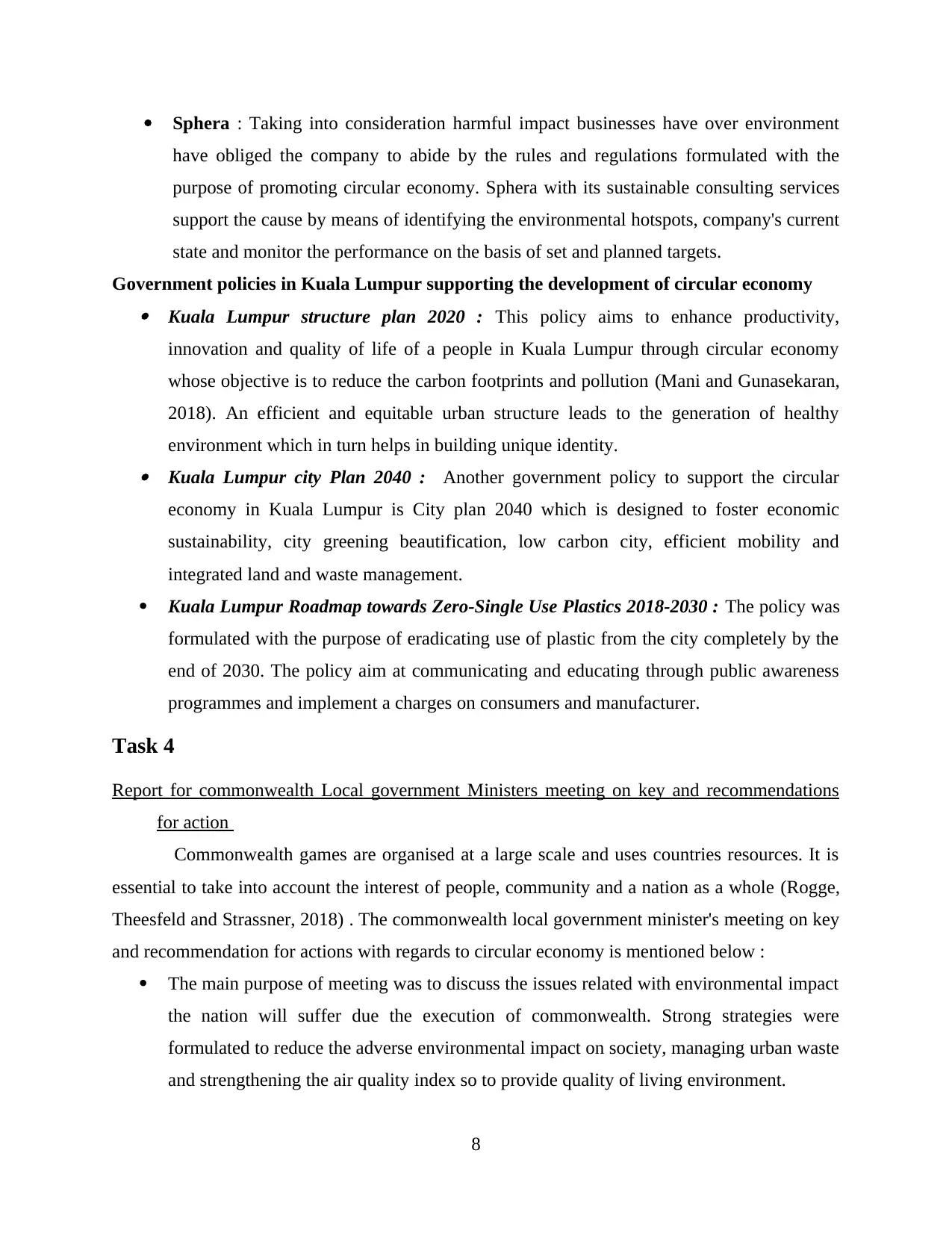
Sphera : Taking into consideration harmful impact businesses have over environment
have obliged the company to abide by the rules and regulations formulated with the
purpose of promoting circular economy. Sphera with its sustainable consulting services
support the cause by means of identifying the environmental hotspots, company's current
state and monitor the performance on the basis of set and planned targets.
Government policies in Kuala Lumpur supporting the development of circular economy Kuala Lumpur structure plan 2020 : This policy aims to enhance productivity,
innovation and quality of life of a people in Kuala Lumpur through circular economy
whose objective is to reduce the carbon footprints and pollution (Mani and Gunasekaran,
2018). An efficient and equitable urban structure leads to the generation of healthy
environment which in turn helps in building unique identity. Kuala Lumpur city Plan 2040 : Another government policy to support the circular
economy in Kuala Lumpur is City plan 2040 which is designed to foster economic
sustainability, city greening beautification, low carbon city, efficient mobility and
integrated land and waste management.
Kuala Lumpur Roadmap towards Zero-Single Use Plastics 2018-2030 : The policy was
formulated with the purpose of eradicating use of plastic from the city completely by the
end of 2030. The policy aim at communicating and educating through public awareness
programmes and implement a charges on consumers and manufacturer.
Task 4
Report for commonwealth Local government Ministers meeting on key and recommendations
for action
Commonwealth games are organised at a large scale and uses countries resources. It is
essential to take into account the interest of people, community and a nation as a whole (Rogge,
Theesfeld and Strassner, 2018) . The commonwealth local government minister's meeting on key
and recommendation for actions with regards to circular economy is mentioned below :
The main purpose of meeting was to discuss the issues related with environmental impact
the nation will suffer due the execution of commonwealth. Strong strategies were
formulated to reduce the adverse environmental impact on society, managing urban waste
and strengthening the air quality index so to provide quality of living environment.
8
have obliged the company to abide by the rules and regulations formulated with the
purpose of promoting circular economy. Sphera with its sustainable consulting services
support the cause by means of identifying the environmental hotspots, company's current
state and monitor the performance on the basis of set and planned targets.
Government policies in Kuala Lumpur supporting the development of circular economy Kuala Lumpur structure plan 2020 : This policy aims to enhance productivity,
innovation and quality of life of a people in Kuala Lumpur through circular economy
whose objective is to reduce the carbon footprints and pollution (Mani and Gunasekaran,
2018). An efficient and equitable urban structure leads to the generation of healthy
environment which in turn helps in building unique identity. Kuala Lumpur city Plan 2040 : Another government policy to support the circular
economy in Kuala Lumpur is City plan 2040 which is designed to foster economic
sustainability, city greening beautification, low carbon city, efficient mobility and
integrated land and waste management.
Kuala Lumpur Roadmap towards Zero-Single Use Plastics 2018-2030 : The policy was
formulated with the purpose of eradicating use of plastic from the city completely by the
end of 2030. The policy aim at communicating and educating through public awareness
programmes and implement a charges on consumers and manufacturer.
Task 4
Report for commonwealth Local government Ministers meeting on key and recommendations
for action
Commonwealth games are organised at a large scale and uses countries resources. It is
essential to take into account the interest of people, community and a nation as a whole (Rogge,
Theesfeld and Strassner, 2018) . The commonwealth local government minister's meeting on key
and recommendation for actions with regards to circular economy is mentioned below :
The main purpose of meeting was to discuss the issues related with environmental impact
the nation will suffer due the execution of commonwealth. Strong strategies were
formulated to reduce the adverse environmental impact on society, managing urban waste
and strengthening the air quality index so to provide quality of living environment.
8
Secure Best Marks with AI Grader
Need help grading? Try our AI Grader for instant feedback on your assignments.
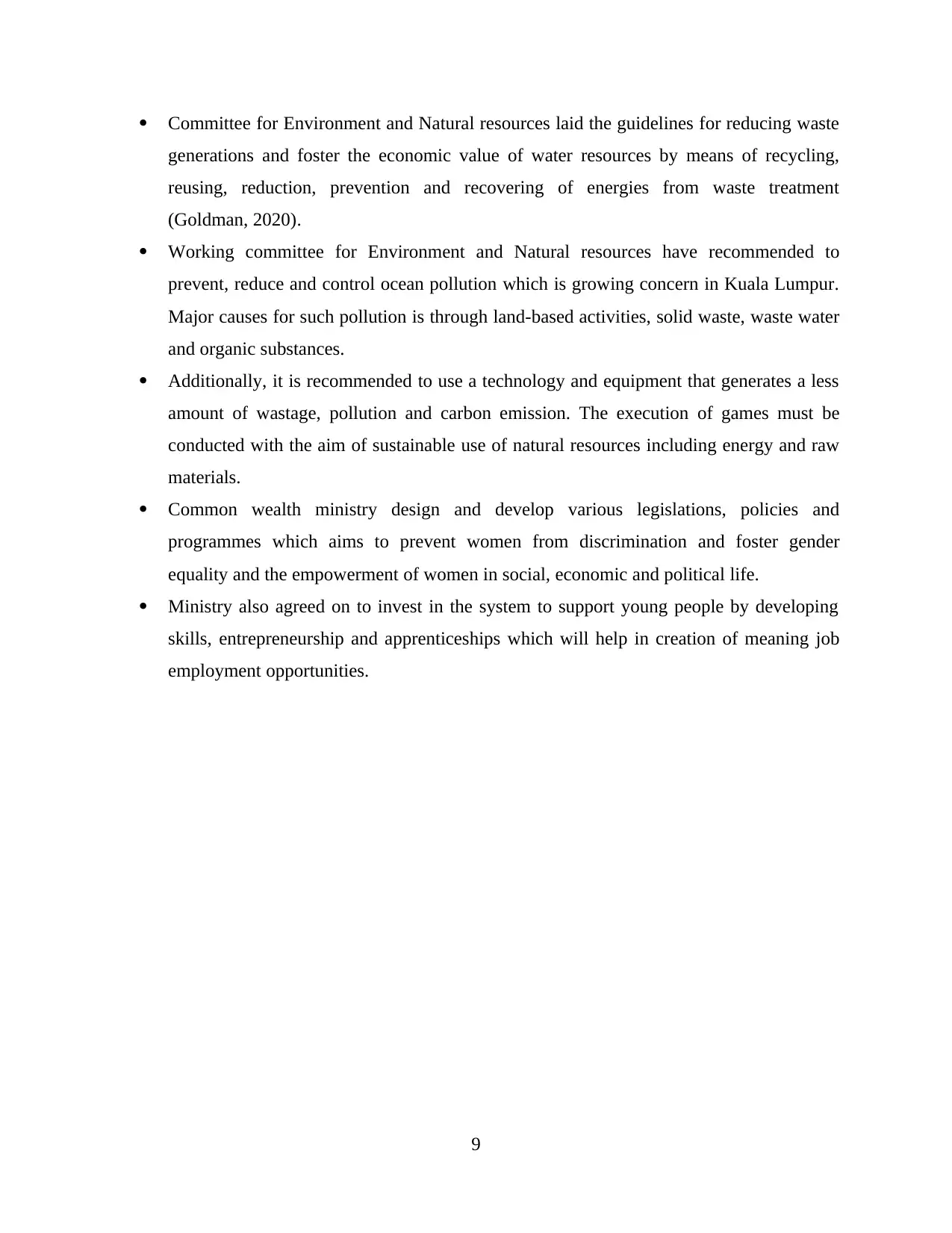
Committee for Environment and Natural resources laid the guidelines for reducing waste
generations and foster the economic value of water resources by means of recycling,
reusing, reduction, prevention and recovering of energies from waste treatment
(Goldman, 2020).
Working committee for Environment and Natural resources have recommended to
prevent, reduce and control ocean pollution which is growing concern in Kuala Lumpur.
Major causes for such pollution is through land-based activities, solid waste, waste water
and organic substances.
Additionally, it is recommended to use a technology and equipment that generates a less
amount of wastage, pollution and carbon emission. The execution of games must be
conducted with the aim of sustainable use of natural resources including energy and raw
materials.
Common wealth ministry design and develop various legislations, policies and
programmes which aims to prevent women from discrimination and foster gender
equality and the empowerment of women in social, economic and political life.
Ministry also agreed on to invest in the system to support young people by developing
skills, entrepreneurship and apprenticeships which will help in creation of meaning job
employment opportunities.
9
generations and foster the economic value of water resources by means of recycling,
reusing, reduction, prevention and recovering of energies from waste treatment
(Goldman, 2020).
Working committee for Environment and Natural resources have recommended to
prevent, reduce and control ocean pollution which is growing concern in Kuala Lumpur.
Major causes for such pollution is through land-based activities, solid waste, waste water
and organic substances.
Additionally, it is recommended to use a technology and equipment that generates a less
amount of wastage, pollution and carbon emission. The execution of games must be
conducted with the aim of sustainable use of natural resources including energy and raw
materials.
Common wealth ministry design and develop various legislations, policies and
programmes which aims to prevent women from discrimination and foster gender
equality and the empowerment of women in social, economic and political life.
Ministry also agreed on to invest in the system to support young people by developing
skills, entrepreneurship and apprenticeships which will help in creation of meaning job
employment opportunities.
9
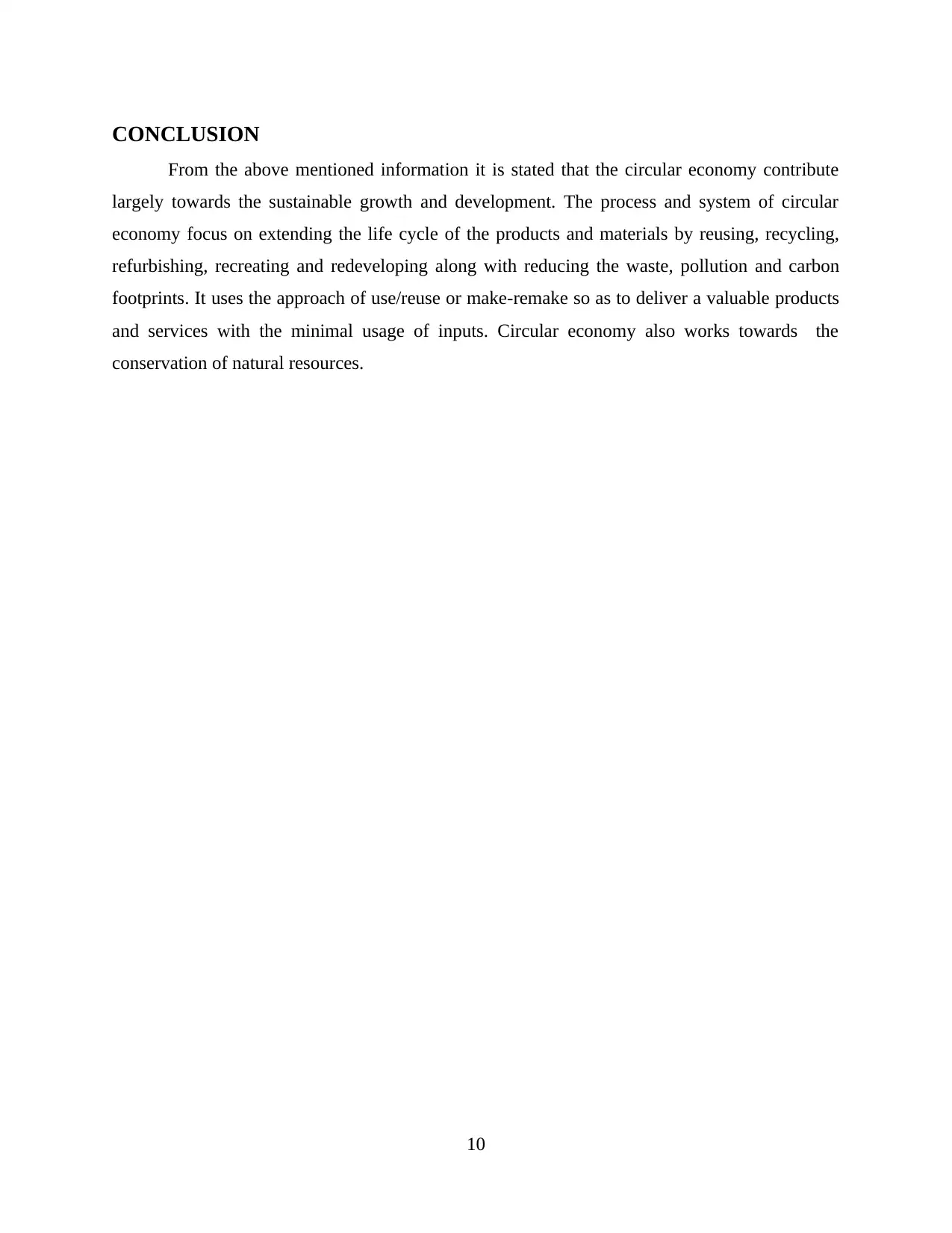
CONCLUSION
From the above mentioned information it is stated that the circular economy contribute
largely towards the sustainable growth and development. The process and system of circular
economy focus on extending the life cycle of the products and materials by reusing, recycling,
refurbishing, recreating and redeveloping along with reducing the waste, pollution and carbon
footprints. It uses the approach of use/reuse or make-remake so as to deliver a valuable products
and services with the minimal usage of inputs. Circular economy also works towards the
conservation of natural resources.
10
From the above mentioned information it is stated that the circular economy contribute
largely towards the sustainable growth and development. The process and system of circular
economy focus on extending the life cycle of the products and materials by reusing, recycling,
refurbishing, recreating and redeveloping along with reducing the waste, pollution and carbon
footprints. It uses the approach of use/reuse or make-remake so as to deliver a valuable products
and services with the minimal usage of inputs. Circular economy also works towards the
conservation of natural resources.
10
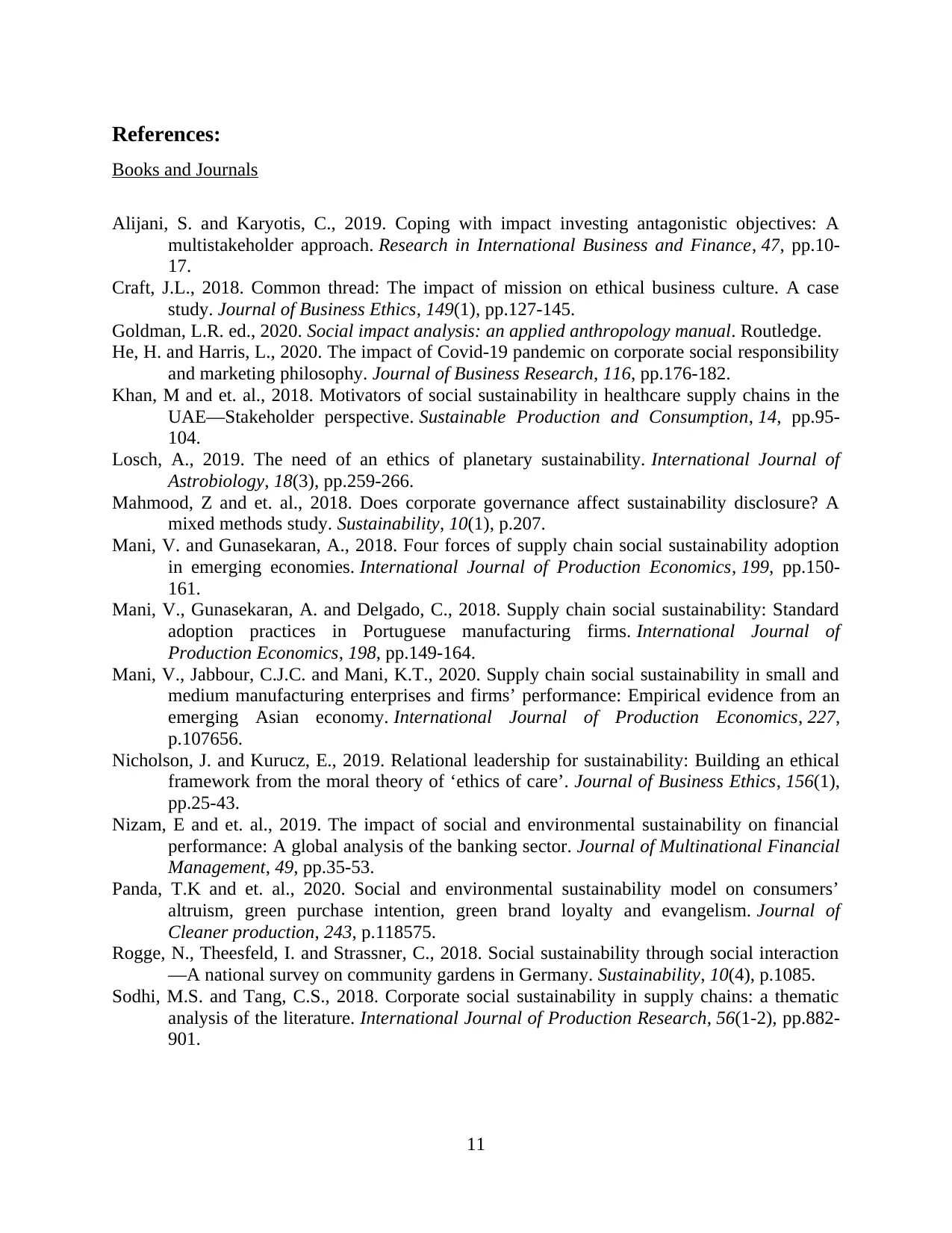
References:
Books and Journals
Alijani, S. and Karyotis, C., 2019. Coping with impact investing antagonistic objectives: A
multistakeholder approach. Research in International Business and Finance, 47, pp.10-
17.
Craft, J.L., 2018. Common thread: The impact of mission on ethical business culture. A case
study. Journal of Business Ethics, 149(1), pp.127-145.
Goldman, L.R. ed., 2020. Social impact analysis: an applied anthropology manual. Routledge.
He, H. and Harris, L., 2020. The impact of Covid-19 pandemic on corporate social responsibility
and marketing philosophy. Journal of Business Research, 116, pp.176-182.
Khan, M and et. al., 2018. Motivators of social sustainability in healthcare supply chains in the
UAE—Stakeholder perspective. Sustainable Production and Consumption, 14, pp.95-
104.
Losch, A., 2019. The need of an ethics of planetary sustainability. International Journal of
Astrobiology, 18(3), pp.259-266.
Mahmood, Z and et. al., 2018. Does corporate governance affect sustainability disclosure? A
mixed methods study. Sustainability, 10(1), p.207.
Mani, V. and Gunasekaran, A., 2018. Four forces of supply chain social sustainability adoption
in emerging economies. International Journal of Production Economics, 199, pp.150-
161.
Mani, V., Gunasekaran, A. and Delgado, C., 2018. Supply chain social sustainability: Standard
adoption practices in Portuguese manufacturing firms. International Journal of
Production Economics, 198, pp.149-164.
Mani, V., Jabbour, C.J.C. and Mani, K.T., 2020. Supply chain social sustainability in small and
medium manufacturing enterprises and firms’ performance: Empirical evidence from an
emerging Asian economy. International Journal of Production Economics, 227,
p.107656.
Nicholson, J. and Kurucz, E., 2019. Relational leadership for sustainability: Building an ethical
framework from the moral theory of ‘ethics of care’. Journal of Business Ethics, 156(1),
pp.25-43.
Nizam, E and et. al., 2019. The impact of social and environmental sustainability on financial
performance: A global analysis of the banking sector. Journal of Multinational Financial
Management, 49, pp.35-53.
Panda, T.K and et. al., 2020. Social and environmental sustainability model on consumers’
altruism, green purchase intention, green brand loyalty and evangelism. Journal of
Cleaner production, 243, p.118575.
Rogge, N., Theesfeld, I. and Strassner, C., 2018. Social sustainability through social interaction
—A national survey on community gardens in Germany. Sustainability, 10(4), p.1085.
Sodhi, M.S. and Tang, C.S., 2018. Corporate social sustainability in supply chains: a thematic
analysis of the literature. International Journal of Production Research, 56(1-2), pp.882-
901.
11
Books and Journals
Alijani, S. and Karyotis, C., 2019. Coping with impact investing antagonistic objectives: A
multistakeholder approach. Research in International Business and Finance, 47, pp.10-
17.
Craft, J.L., 2018. Common thread: The impact of mission on ethical business culture. A case
study. Journal of Business Ethics, 149(1), pp.127-145.
Goldman, L.R. ed., 2020. Social impact analysis: an applied anthropology manual. Routledge.
He, H. and Harris, L., 2020. The impact of Covid-19 pandemic on corporate social responsibility
and marketing philosophy. Journal of Business Research, 116, pp.176-182.
Khan, M and et. al., 2018. Motivators of social sustainability in healthcare supply chains in the
UAE—Stakeholder perspective. Sustainable Production and Consumption, 14, pp.95-
104.
Losch, A., 2019. The need of an ethics of planetary sustainability. International Journal of
Astrobiology, 18(3), pp.259-266.
Mahmood, Z and et. al., 2018. Does corporate governance affect sustainability disclosure? A
mixed methods study. Sustainability, 10(1), p.207.
Mani, V. and Gunasekaran, A., 2018. Four forces of supply chain social sustainability adoption
in emerging economies. International Journal of Production Economics, 199, pp.150-
161.
Mani, V., Gunasekaran, A. and Delgado, C., 2018. Supply chain social sustainability: Standard
adoption practices in Portuguese manufacturing firms. International Journal of
Production Economics, 198, pp.149-164.
Mani, V., Jabbour, C.J.C. and Mani, K.T., 2020. Supply chain social sustainability in small and
medium manufacturing enterprises and firms’ performance: Empirical evidence from an
emerging Asian economy. International Journal of Production Economics, 227,
p.107656.
Nicholson, J. and Kurucz, E., 2019. Relational leadership for sustainability: Building an ethical
framework from the moral theory of ‘ethics of care’. Journal of Business Ethics, 156(1),
pp.25-43.
Nizam, E and et. al., 2019. The impact of social and environmental sustainability on financial
performance: A global analysis of the banking sector. Journal of Multinational Financial
Management, 49, pp.35-53.
Panda, T.K and et. al., 2020. Social and environmental sustainability model on consumers’
altruism, green purchase intention, green brand loyalty and evangelism. Journal of
Cleaner production, 243, p.118575.
Rogge, N., Theesfeld, I. and Strassner, C., 2018. Social sustainability through social interaction
—A national survey on community gardens in Germany. Sustainability, 10(4), p.1085.
Sodhi, M.S. and Tang, C.S., 2018. Corporate social sustainability in supply chains: a thematic
analysis of the literature. International Journal of Production Research, 56(1-2), pp.882-
901.
11
Paraphrase This Document
Need a fresh take? Get an instant paraphrase of this document with our AI Paraphraser

12
1 out of 14
Related Documents
Your All-in-One AI-Powered Toolkit for Academic Success.
+13062052269
info@desklib.com
Available 24*7 on WhatsApp / Email
![[object Object]](/_next/static/media/star-bottom.7253800d.svg)
Unlock your academic potential
© 2024 | Zucol Services PVT LTD | All rights reserved.





